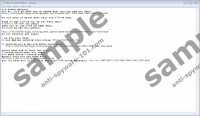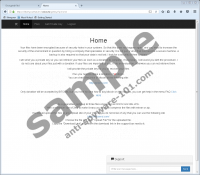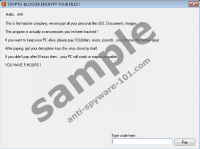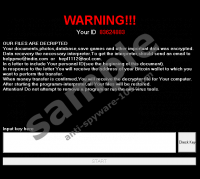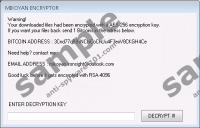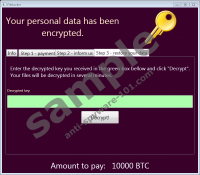The files encrypted by the malicious Frozrlock Ransomware can be very hard to identify because they are not marked with a unique extension, which is what usually happens when ransomware encrypts files. Because of that, the only way to know which files were corrupted by this threat is by trying to open every single file. Of course, the chances are that every single file on your computer – except Windows elements and files in %WINDIR%f – was encrypted. This malicious threat, of course, targets documents, media files, and photos first, but it can also corrupt the files of downloaded applications. Due to this, you might find that you can no longer use your browser and other apps. While you can restore your web browser, restoring personal files might be more complicated. Hopefully, these files are backed up; otherwise, they might be lost for good. Continue reading to learn all about the encryption of your files, as well as how to delete Frozrlock Ransomware (also known as FileFrozr Ransomware). Read more »
Trojans - Page 117 category archyve:
Nm4 Ransomware
Perhaps Nm4 Ransomware is not as dangerous as WannaCry Ransomware, but it is still one of the many malicious applications out there that want to rip you off. Also, it just proves how dire the situation is right now, and how “popular” ransomware programs are at the moment.
Unfortunately, there is no public tool at the moment that would help you restore the files affected by this infection, so the best way to solve this problem would be retrieving your files from a file backup. As for the ransomware removal, it is not that hard to delete Nm4 Ransomware from your PC. Read more »
Failedaccess Ransomware
Failedaccess Ransomware is a dangerous file-encrypting application that was named accordingly to the extension, which is added to the threat’s damaged files. The strangest part is that the malware’s creators ask to pay some money and do not even specify the account where the money should be transferred. Therefore, it seems it is impossible to purchase the offered decryption tool. Of course, even if the infection provided payment details, we would still advise against it as there is always a possibility you could end up losing the invested money for nothing. Given the circumstances, there is nothing left to do but to eliminate Failedaccess Ransomware and start afresh. If you continue reading the article, we will tell you more about the malicious program, and below the text, you can find instructions showing how to delete the malware manually. Read more »
BitKangoroo Ransomware
Do you have 1862 US Dollars just lying around? If you do not, fulfilling the demands of the BitKangoroo Ransomware might be complicated. When this devious infection slithers in, it encrypts your files and then requests a payment of 1 Bitcoin – which, at the moment, translates to the sum above – to be paid within an hour. Even if money is not an issue, paying the ransom is risky because it is unlikely that the promised decryption key would be provided to you after paying it. Needless to say, you are in a sticky situation if this ransomware has invaded your operating system and encrypted your files. The good news is that you should be able to find a decryptor that can decrypt your files for free, and that is not something that happens often. Hopefully, you manage to get your files decrypted, and you can delete BitKangoroo Ransomware without any hesitation. Note that if your files are freed, the malicious components are still active, and you will not be safe until you remove them from your PC. Read more »
Crypto-Blocker Ransomware
The name Crypto-Blocker Ransomware might give you the impression that it is a serious computer infection, but it is not, actually. If your PC has become infected with it, you can go right ahead and remove it without hesitation. It was designed to encrypt your personal files and demand that you pay a ransom for a decryption key. However, we have received information that there is a free decryption tool that is capable of dealing with this particular ransomware. To find out more about this rather dangerous application, we invite you to read this whole article. Read more »
Mordor Ransomware
For those who are familiar with the Lord of the Rings trilogy the very title of Mordor Ransomware should make it clear it is a dangerous application as the word Mordor translates into The Black Land or The Land of Shadows. However, compared with other threats alike, the malware does not seem to be so harmful. According to our computer security specialists at Anti-spyware-101.com, the malicious application does not lock the screen or damage data belonging to the operating system. In other words, if you encounter such threat you might lose all personal data, but at least you could still be able to use the computer normally, although we would recommend erasing the infection first. Mordor Ransomware can be eliminated manually with the instructions located below or with a reliable antimalware tool. Read more »
RSAUtil Ransomware
RSAUtil Ransomware is a severe threat that can be responsible for rendering most of your files unusable. Once this beast manages to infiltrate your system, it can initiate the attack behind your back and encrypt your photos, videos, documents, archives, and even your .exe files to take them hostage. The main idea behind it is obviously extorting money from you for the decryption of your files. When it comes to ransomware infections it is important to understand that even if you have a backup copy of your most important files on a removable drive, it has to be always unplugged when not in use. Such a ransomware program can attack all mapped drives and unmapped network shares as well. So, if your removable drive is connected, you could lose all your files on it to this malicious attack. Also, some ransomware infections are capable of logging into your cloud storage account and destroy your files there. Although you are offered a way out of this vicious threat by paying a ransom fee to these criminals, we suggest that you do not consider it as an option. There is a good chance that these crooks would send more infections onto your computer disguised as a decryption tool or key. We recommend that you remove RSAUtil Ransomware immediately so that you can start recovering your files if you have a backup. Read more »
Amnesia Ransomware
Files marked by an additional extension called .amnesia could only mean the user has encountered a file-encrypting malicious application known as Amnesia Ransomware. If you happen to be one of these unfortunate users, we advise you no to fund the hackers behind Amnesia Ransomware. We have no doubt they do not care they may have ruined files that could have been irreplaceable. Sadly, all they care about is how to make you pay a ransom. The hackers can promise to send decryption tools as soon as you make the payment, but who can guarantee they will bother to do so once your savings reach their account. Consequently, our specialists recommend using alternative recovery methods instead, e.g. backup files, copies on removable media devices, etc. Just firstly, it would be wise to delete the infection with the instructions located below or reliable antimalware software. However, if you still have doubts, it might be best to read the article first. Read more »
Mikoyan Ransomware
Mikoyan Ransomware, also known to be Mikoyan Encryptor, is a recently detected ransomware-type infection based on Hidden Tear, an open-source ransomware developed for educational purposes. At the time of writing, it is not spread actively, and, according to specialists working at anti-spyware-101.com, should not affect many users because it has been originally developed for testing and affects only one folder purposefully created by the developer of ransomware. Of course, no one knows what the future holds, so, theoretically, this infection might be updated and become prevalent. Are you reading this article because you have encountered this threat and found your files encrypted? If so, go to uninstall Mikoyan Ransomware without consideration and do not send a cent to its author for the decryption of files although it might seem to be the easiest way to get files back because there are no guarantees that your files will be unlocked for you or that you will receive a key for unlocking them. Read more »
AutoEncryptor Ransomware
AutoEncryptor Ransomware is a malicious computer infection whose ultimate goal is to obtain your money. Ransomware infections are created massively with the aim of making victims pay large sums of money, which vary approximately from 100 to 500 US dollars. The latest ransomware infections provide requirements to use the digital currency Bitcoins, which enables attackers' anonymity. In the case of AutoEncryptor Ransomware, the attackers seem to be unaware of the value of 1 bitcoin as they demand a 10.000 bitcoins release fee. This amount of money is more than 10 million US dollars. In general, a lot of unsuspecting computer users get trapped by ransomware and pay the money required, but the victims affected by the AutoEncryptor Ransomware are likely not able to afford their data recovery. All that you can do with the AutoEncryptor infection is remove it from the PC and take action to prevent similar future incidents. Read more »
